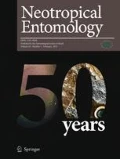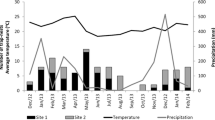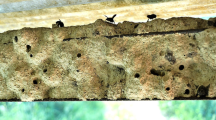Abstract
Males of euglossine bees, also known as orchid bees, are attracted to aromatic compounds and this feature has been exploited to collect them. Here we sampled orchid bee males using a rapid passive method in a Neotropical savanna ecosystem in Rio Preto State Park (PERP), southeastern Brazil. The sampling protocol consisted of 5-day surveys using scent traps at the beginning and end of the rainy seasons. PERP is inserted in a Brazilian savanna characterized by a mosaic of vegetation types, and elevational gradients. We also analyzed whether the habitat complexity and elevational gradients influence the richness and abundance of these bees. We collected a total of 996 individuals belonging to 14 species and four genera (Eufriesea Cockerell 1908, Euglossa Latreille 1802, Eulaema Lepeletier 1841, and Exaerete Hoffmannsegg 1817). Comparing our results with previous sampling protocols at PERP, higher abundance and richness were observed using traps than insect nets to survey these bees. In addition, the orchid bee fauna in PERP was successfully assessed by our rapid passive protocol, showing that this protocol seems to be useful for collecting orchid bees in open vegetation environments. We observed that the abundance of bees was lower at higher elevations, and both abundance and richness increased in more complex habitat. This may be due to the characteristics of Brazilian savannas where the lower elevations have higher habitat complexity, with more places for nest construction and resources for feeding and nesting.



Similar content being viewed by others
References
Alvarenga PEF, Freitas RF, Augusto SC (2007) Diversidade de Euglossini (Hymenoptera: Apidae) em áreas de Cerrado do triângulo mineiro, MG. Biosci J 23:30–37
Andrade-Silva ACR, Nemésio A, de Oliveira FF, Nascimento FS (2012) Spatial–temporal variation in orchid bee communities (Hymenoptera: Apidae) in remnants of arboreal Caatinga in the Chapada Diamantina region, State of Bahia, Brazil. Neotrop Entomol 41(4):296–305. https://doi.org/10.1007/s13744-012-0053-9
Antonini Y, Silveira RA, Oliveira M, Martins C, Oliveira R (2016) Orchid bee fauna responds to habitat complexity on a savanna area (Cerrado) in Brazil. Sociobiology 63(2):819–825. https://doi.org/10.13102/sociobiology.v63i2.1038
Ascher JS, Pickering J (2020) Discover Life bee species guide and world checklist (Hymenoptera: Apoidea: Anthophila). http://www.discoverlife.org/mp/20q?guide=Apoidea_species. Accessed 11 May 2021
Augusto SC, Garófalo CA (2007) Nesting of Euglossa (Euglossa) melanotricha Moure (Hymenoptera: Apidae) in the ground of cerrado. Neotrop Entomol 36(1):153–156. https://doi.org/10.1590/s1519-566x2007000100021
Campos LA, Silveira FAD, Oliveira MLD, Abrantes CV, Morato EF, De Melo GA (1989) Utilização de armadilhas para a captura de machos de Euglossini (Hymenoptera, Apoidea). Rev Bras Zool 6(4):621–626. https://doi.org/10.1590/S0101-81751989000400008
Cândido MEM, Morato EF, Storck-Tonon D, Miranda PN, Vieira LJ (2018) Effects of fragments and landscape characteristics on the orchid bee richness (Apidae: Euglossini) in an urban matrix, southwestern Amazonia. J Insect Conserv 22(3):475–486. https://doi.org/10.1007/s10841-018-0075-7
Carneiro LS, Aguiar WM, Aguiar CML, Santos GMM (2018) Orchid bees (Hymenoptera: Apidae: Euglossini) in seasonally dry tropical forest (Caatinga) in Brazil. Sociobiology 65(2):253–258. https://doi.org/10.13102/sociobiology.v65i2.2077
Colwell RK (2013) EstimateS: Statistical estimation of species richness and shared species from samples. Version 9 (Software and User’s Guide). http://viceroy.eeb.uconn.edu/estimates. Accessed 4 Feb 2021
Coops NC, Catling PC (1997) Predicting the complexity of habitat in forests from airborne videography for wildlife management. Int J Remote Sens 18(12):2677–2682. https://doi.org/10.1080/014311697217530
Cordeiro M, Garraffoni ARS, Lourenço AP (2019) Rapid assessment of the orchid bee fauna (Hymenoptera: Apidae: Euglossini) in the vicinity of an urban Atlantic Forest remnant in São Paulo, Brazil. Braz J Biol 79:149–151. https://doi.org/10.1590/1519-6984.171286
Dodson CH, Dressler RL, Hills HG, Adams RM, Williams NH (1969) Biologically active compounds in orchid fragrances. Science 164:1243–1249. https://doi.org/10.1126/science.164.3885.1243
Dressler RL (1982) Biology of the orchid bees (Euglossini). Annu Rev Ecol Syst 13(1):373–394. https://doi.org/10.1146/annurev.es.13.110182.002105
Eltz T, Whitten WM, Roubik DW, Linsenmair KE (1999) Fragrance collection, storage, and accumulation by individual male orchid bees. J Chem Ecol 25(1):157–176. https://doi.org/10.1023/A:1020897302355
Eltz T, Roubik DW, Leunau K (2005) Experience-dependent choices ensure species-specific fragrance accumulation in male orchid bees. Behav Ecol Sociobiol 59:149–156. https://doi.org/10.1007/s00265-005-0021-z
Furley PA (1999) The nature and diversity of neotropical savanna vegetation with particular reference to the Brazilian cerrados. Glob Ecol Biogeogr 8:223–241. https://doi.org/10.1046/j.1466-822X.1999.00142.x
Garraffoni ARS, Moura FR, Lourenço AP (2017) Areas of endemism in the Atlantic Forest: quantitative biogeography insights from orchid bees (Apidae: Euglossini). Apidologie 48(4):513–522. https://doi.org/10.1007/s13592-017-0494-6
Giangarelli DC, De Aguiar WM, Sofia SH (2015) Orchid bee (Hymenoptera: Apidae: Euglossini) assemblages from three different threatened phytophysiognomies of the subtropical Brazilian Atlantic Forest. Apidologie 46(1):71–83. https://doi.org/10.1007/s13592-014-0303-4
Hammer Ø, Harper DAT, Ryan PD (2001) PAST: paleontological statistics software package for education and data analysis. Palaeontol Electron 4:1–9
Hinojosa-Díaz IA (2013) Presence of Euglossa (Euglossa) amazonica outside of the Amazon Basin–biogeographic insights. J Melittology 2:1–6. https://doi.org/10.17161/jom.v0i2.4434
Janzen DH (1971) Euglossine bees as long-distance pollinators of tropical plants. Science 171(3967):203–205. https://doi.org/10.1126/science.171.3967.203
Janzen DH, Devries PJ, Heggins ML, Kimsey LS (1982) Seasonal and site variation in Costa Rican euglossine bees at chemical baits in lowland deciduous and evergreen forests. Ecology 63(1):66–74. https://doi.org/10.2307/1937032
Justino DG, Augusto SC (2010) Avaliação da eficiência de coleta utilizando armadilhas aromáticas e riqueza de Euglossini (Hymenoptera, Apidae) em áreas de Cerrado do Triângulo Mineiro. Rev Bras Zoociências 12(3):227–239
Kamke R, Zillikens A, Heinle S, Steiner J (2008) Natural enemies and life cycle of the orchid bee Eufriesea smaragdina (Hymenoptera: Apidae) reared from trap nests. J Kansas Entomol Soc 81(2):101–109. https://doi.org/10.2317/JKES-703.26.1
Kearn CA, Inouye DW, Waser NM (1998) Endangered mutualisms: the conservation of plant-pollinator interactions. Annu Rev Ecol Syst 29:83–112. https://doi.org/10.1146/annurev.ecolsys.29.1.83
Leão-Gomes B, Nemésio A (2020) Orchid bees (Hymenoptera: Apidae: Euglossina) of a savanna-like ‘Cerrado’ remnant inside an urban area in Central Brazil. North-West J Zool 16(1):50–58. https://doi.org/10.1590/S1519-566X2007000200003
Lundberg J, Moberg F (2003) Mobile link organisms and ecosystem functioning: implications for ecosystem resilience and management. Ecosystems 6:87–98. https://doi.org/10.1007/s10021-002-0150-4
Mattozo VC, Faria LR, Melo GA (2011) Orchid bees (Hymenoptera: Apidae) in the coastal forests of southern Brazil: diversity, efficiency of sampling methods and comparison with other Atlantic forest surveys. Pap Avulsos Zool 51(33):505–515. https://doi.org/10.1590/S0031-10492011003300001
Menezes NL, Giulietti AM (2000) Campos Rupestres. In: Mendonça MP, Lins LV (orgs.) Lista vermelha das espécies ameaçadas de extinção da flora de Minas Gerais. Fundação Biodiversitas, Fundação Zoo-Botânica, Belo Horizonte, pp 65-74
Michener CD (2007) The bees of the world, 2nd edn. The Jonhs Hopkins University Press, Baltimore
Moreira EF, Santos RLDS, Silveira MS, Boscolo D, Neves ELD, Viana BF (2017) Influence of landscape structure on Euglossini composition in open vegetation environments. Biota Neotrop 17(1):e20160294. https://doi.org/10.1590/1676-0611-bn-2016-0294
Moure JS, Melo GAR, Faria Jr. LRR (2012) Euglossini Latreille, 1802. In Moure JS, Urban D, Melo GAR (Orgs). Catalogue of bees (Hymenoptera, Apoidea) in the neotropical region. http://www.moure.cria.org.br/catalogue. Accessed 10 March 2021
Nemésio A (2008) Orchid bee community (Hymenoptera, Apidae) at an altitudinal gradient in a large forest fragment in southeastern Brazil. Rev Bras Zoociências 10(3):249–256
Nemésio A (2009) Orchid bees (Hymenoptera: Apidae) of the Brazilian Atlantic Forest. Zootaxa 2041(1):1–242. https://doi.org/10.11646/zootaxa.2041.1.1
Nemésio A (2010a) Eulaema (Apeulaema) felipei sp. n. (Hymenoptera: Apidae: Euglossina): a new forest-dependent orchid bee found at the brink of extinction in northeastern Brazil. Zootaxa 2424:51–62. https://doi.org/10.11646/zootaxa.2424.1.3
Nemésio A (2010b) The orchid-bee fauna (Hymenoptera: Apidae) of a forest remnant in northeastern Brazil, with new geographic records and an identification key to the known species of the Atlantic Forest of northeastern Brazil. Zootaxa 2656:55–66. https://doi.org/10.11646/zootaxa.2656.1.3
Nemésio A (2012a) Methodological concerns and challenges in ecological studies with orchid bees (Hymenoptera: Apidae: Euglossina). Biosci J 28(1):188–134
Nemésio A (2012b) The western limits of the “Hileia Baiana” for orchid bees, including seven new records for the state of Minas Gerais, eastern Brazil. Spixiana 35(1):109–116
Nemésio A (2016) Orchid bees (Hymenoptera, Apidae) from the Brazilian savanna-like ‘Cerrado’: how to adequately survey under low population densities? North-West J Zool 12(2):230–238
Nemésio A, Faria LR Jr (2004) First assessment of the orchid-bee fauna (Hymenoptera: Apidae) at Parque Estadual do Rio Preto, a cerrado area in southeastern Brazil. Lundiana 5(2):113–117
Nemésio A, Morato EF (2004) Euglossina (Hymenoptera: Apidae: Apini) of the Humaitá Reserve, Acre state, Brazilian Amazon, with comments on bait trap efficiency. Rev CTA 10(2):71–80
Nemésio A, Morato EF (2006) The orchid-bee fauna (Hymenoptera: Apidae) of Acre state (northwestern Brazil) and a reevaluation of euglossine bait-trapping. Lundiana 7:59–64
Nemésio A, Rasmussen C (2014) Sampling a biodiversity hotspot: the orchid-bee fauna (Hymenoptera: Apidae) of Tarapoto, northeastern Peru, the richest and most diverse site of the Neotropics. Braz J Biol 74(3):s33–s44. https://doi.org/10.1590/1519-6984.20412
Nemésio A, Silveira FA (2006) Edge effects on the orchid-bee fauna (Hymenoptera: Apidae) at a large remnant of Atlantic Rain Forest in southeastern Brazil. Neotrop Entomol 35(3):313–323. https://doi.org/10.1590/S1519-566X2006000300004
Nemésio A, Silveira FA (2010) Forest fragments with larger core areas better sustain diverse orchid bee faunas (Hymenoptera: Apidae: Euglossina). Neotrop Entomol 39(4):555–561. https://doi.org/10.1590/S1519-566X2010000400014
Nemésio A, Vasconcelos HL (2014) Effectiveness of two sampling protocols to survey orchid bees (Hymenoptera: Apidae) in the Neotropics. J Insect Conserv 18(2):197–202. https://doi.org/10.1007/s10841-014-9629-5
Nemésio A, Santos LM, Vasconcelos HL (2015) Long-term ecology of orchid bees in an urban forest remnant. Apidologie 46(3):359–368. https://doi.org/10.1007/s13592-014-0328-8
Neves SCN, Abreu PAA, Fraga LMS (2005) Fisiografia. In: Silva AC, Pedreira LCVSF, Abreu PAA (eds) Serra do Espinhaço Meridional: Paisagens e ambientes. O Lutador, Belo Horizonte, pp 47–58
Pokorny T, Loose D, Dyker G, Quezada-Euán JJG, Eltz T (2015) Dispersal ability of male orchid bees and direct evidence for long-range flights. Apidologie 46:224–237. https://doi.org/10.1007/s13592-014-0317-y
Potts SG, Biesmeijer JC, Kremen C, Neumann P, Schweiger O, Kunin WE (2010) Global pollinator declines: trends, impacts and drivers. Trends Ecol Evol 25(6):345–353. https://doi.org/10.1016/j.tree.2010.01.007
Prado SG, Ngo HT, Florez JA, Collazo JA (2017) Sampling bees in tropical forests and agroecosystems: a review. J Insect Conserv 21(5):753–770. https://doi.org/10.1007/s10841-017-0018-8
Quinto J, Marcos-Garcia MA, Brustel H, Galante E, Mico E (2013) Effectiveness of three sampling methods to survey saproxylic beetles in Mediterranean woodland. J Insect Conserv 17:765–776. https://doi.org/10.1007/s10841-013-9559-7
Ramírez S (2005) Euglossa paisa, a new species of orchid bee from the Colombian Andes (Hymenoptera: Apidae). Zootaxa 1065:51–60. https://doi.org/10.11646/zootaxa.1065.1.3
Ramírez SR, Eltz T, Fritzsch F, Pemberton R, Pringle EG (2010) Intraspecific geographic variation of fragrances acquired by orchid bees in native and introduced populations. J Chem Ecol 36:873–884. https://doi.org/10.1007/s10886-010-9821-3
Rebêlo JMM, Moure JS (1995) The species of Euglossa Latreille from the northeast of São Paulo, Brazil (Apidae, Euglossinae). Rev Bras Zool 12(3):445–466. https://doi.org/10.1590/S0101-81751995000300001
Rocha-Filho LC, Montagnana PC, Boscolo D, Garófalo CA (2020) Species turnover and low stability in a community of euglossine bees (Hymenoptera: Apidae) sampled within 28 years in an urban forest fragment. Apidologie 51:921–934. https://doi.org/10.1007/s13592-020-00772-3
Santos ML, Garófalo CA (1994) Nesting biology and nest re-use of Eulaema nigrita (Hymenoptera: Apidae, Euglossini). Insect Soc 41(1):99–110. https://doi.org/10.1007/BF01240577
Santos Jr JE, Ferrari RR, Nemésio A (2014) The orchid-bee fauna (Hymenoptera: Apidae) of a forest remnant in the southern portion of the Brazilian Amazon. Braz J Biol 74(3):S184–S190. https://doi.org/10.1590/1519-6984.25712
Santos FM, Beiroz W, Antonini Y, Martén-Rodríguez S, Quesada M, Fernandes GW (2020) Structure and composition of the euglossine bee community along an elevational gradient of rupestrian grassland vegetation. Apidologie 51(4):675–687. https://doi.org/10.1007/s13592-020-00752-7
Shannon P, Markiel A, Ozier O, Baliga NS, Wang JT, Ramage D, Amin N, Schwikowski B, Ideker T (2003) Cytoscape: a software environment for integrated models of biomolecular interaction networks. Genome Res 13(11):2498–2504. https://doi.org/10.1101/gr.1239303
Silveira FA, Cure JR (1993) High-altitude bee fauna of southeastern Brazil: implications for biogeographic patterns (Hymenoptera: Apoidea). Stud Neotropical Fauna Environ 28(1):47–55. https://doi.org/10.1080/01650529309360887
Silveira FA, Melo GAR, Almeida (2002) Abelhas brasileiras: Sistemática e identificação, 1st. edn. Fernando Araújo Silveira, Belo Horizonte
Silveira GC, Freitas RF, Tosta TH, Rabelo LS, Gaglianone MC, Augusto SC (2015) The orchid bee fauna in the Brazilian savanna: do forest formations contribute to higher species diversity? Apidologie 46(2):197–208. https://doi.org/10.1007/s13592-014-0314-1
Souza MHS, Dos Anjos-Silva EJ (2020) New and old records of Euglossa imperialis Cockerell, 1922 (Apidae, Apinae, Euglossini) for the Amazon rainforest, Cerrado, and Pantanal of Mato Grosso, Brazil. Check List 16:243–252. https://doi.org/10.15560/16.2.243
Tonhasca A Jr, Blackmer JL, Albuquerque GS (2002) Abundance and diversity of euglossine bees in the fragmented landscape of the Brazilian Atlantic Forest. Biotropica 34(3):416–422. https://doi.org/10.1111/j.1744-7429.2002.tb00555.x
Tosta THA, Silveira GC, Schiavini I, Sofia SH, Augusto SC (2017) Using short-term surveys and mark-recapture to estimate diversity and population size of orchid bees in forest formations of the Brazilian savanna. J Nat Hist 51:391–403. https://doi.org/10.1080/00222933.2016.1274441
Viana TA, Lourenço AP (2020) Surveys of the bee (Hymenoptera: Apiformes) community in a Neotropical savanna using pan traps. Pap Avulsos Zool 60:e2020603. https://doi.org/10.11606/1807-0205/2020.60.31
Viotti MA, Moura FR, Lourenço AP (2013) Species diversity and temporal variation of the orchid bee fauna (Hymenoptera, Apidae) in a conservation gradient of a rocky field area in the Espinhaço Range, State of Minas Gerais, southeastern Brazil. Neotrop Entomol 42:565–575. https://doi.org/10.1007/s13744-013-0164-y
Wolda H (1981) Similarity indices, sample size and diversity. Oecologia 50(3):296–302
Acknowledgements
We thank Nathália Henriques, Priscila Araújo, André Garraffoni, and Thiago Quintão for their assistance during the field samplings, and Jardel Silva for help with figures. We are grateful to André Nemésio and Rafael Ferrari for the identification of the bees, and two anonymous reviewers for their valuable considerations. Field-work in the Rio Preto State Park – Parque Estadual do Rio Preto (PERP) was conducted under the authorization of the Instituto Estadual de Florestas (IEF) do Estado de Minas Gerais.
Funding
This study was supported by MCTI-Rede ComCerrado and CNPq (563134/2010-0).
Author information
Authors and Affiliations
Contributions
APL conceived this research. TAV, FMM, and APL conducted samplings, data analyses, and manuscript writing. All authors read and approved the final manuscript.
Corresponding author
Ethics declarations
Conflict of interest
The authors declare no competing interests.
Additional information
Edited by Fernando B Noll
Publisher’s Note
Springer Nature remains neutral with regard to jurisdictional claims in published maps and institutional affiliations.
Supplementary Information
ESM 1
(DOCX 195 kb)
Rights and permissions
About this article
Cite this article
Viana, T.A., Martins, F.M. & Lourenço, A.P. The Orchid Bee Fauna (Hymenoptera: Apidae: Euglossini) of a Neotropical Savanna: an Efficient Protocol to Assess Bee Community and Diversity Along Elevational and Habitat Complexity Gradients. Neotrop Entomol 50, 748–758 (2021). https://doi.org/10.1007/s13744-021-00899-7
Received:
Accepted:
Published:
Issue Date:
DOI: https://doi.org/10.1007/s13744-021-00899-7




